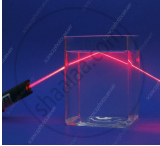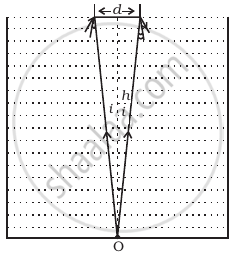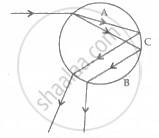Advertisements
Advertisements
प्रश्न
In the following figure, show two rays A and B travelling from water to air. If the critical angle for water- air surface is 48°, complete the ray diagram showing the refracted rays for each. State conditions when the ray will suffer total internal reflection.

उत्तर

The necessary conditions for total internal reflection to occur are
- Light must travel from a denser medium to a rarer medium.
- The angle of incidence must be greater than the critical angle.
In this case, the angle of incidence. ∠ i > 48°
APPEARS IN
संबंधित प्रश्न
A ray of light travels from water to air as shown in the diagram given below :

1) Copy the diagram and complete the path of the way. Given the critical angle for water is 48°.
2) State the condition so that internal reflection occurs in the above diagram.
How does a ray of light bend when it travels from rarer to denser medium
Can light be ‘piped’ like sound in a doctor’s stethoscope?
A ray of light incident at an angle of incidence ‘i’ passes through an equilateral glass prism such that the refracted ray inside the prism is parallel to its base and emerges from the prism at an angle of emergence ‘e’.
How is the angle of emergence ‘e’ related to the angle of incidence ‘i’?
Solve Numerical example.
A monochromatic ray of light is incident at 37° on an equilateral prism of refractive index 3/2. Determine angle of emergence and angle of deviation. If angle of prism is adjustable, what should its value be for emergent rays to be just possible for the same angle of incidence?
Observe the given figure and write appropriate phenomenon of light in the box.

Total internal reflection can take place only if light is travelling from ______.
The angle of incidence at which the angle of refraction is Q£ is called the critical angle.
A jar of height h is filled with a transparent liquid of refractive index µ (Figure). At the centre of the jar on the bottom surface is a dot. Find the minimum diameter of a disc, such that when placed on the top surface symmetrically about the centre, the dot is invisible.

Observe the given figure of the raindrop and answer the following questions:

- Label A and B of the given diagram. Why colour will deviate most.
- Name the phenomenon shown in label C.
